Bulletin – March 2014 Australian Economy Inflation and the Cost of Living
- Download the article 1.25MB
Abstract
This article looks at increases in the cost of living for Australian households over the past decade. Inflation as measured by changes in the consumer price index (CPI) overstates ‘true’ increases in the cost of living due to a number of inherent conceptual differences and measurement issues. Even so, other measures of the cost of living have increased by a similar amount to the CPI over the past decade. Measured inflation has been higher for some households and socio-economic groups than for others, though the differences have generally not been large and have tended to even out over time. Although cost-of-living inflation has been moderate across most households, there are a number of reasons why some households might have perceived inflation to be higher than it actually was.
Introduction
A significant concern for many households is the expense they incur to buy the goods and services that are necessary to maintain a certain standard of living – that is, their ‘cost of living’. The prices of many of these items tend to rise over time, which places upward pressure on the cost of living. The CPI, which measures inflation in prices, is often used to assess changes in the cost of living. Over the past decade, the CPI has increased by around 30 per cent, averaging around 2¾ per cent per year. This pace of increase has been consistent with the Reserve Bank's target of keeping CPI inflation between 2 and 3 per cent per year, on average, over the business cycle. This rate of inflation has also been low compared with that in the two decades prior to the Reserve Bank's adoption of an inflation target (in 1993), when CPI inflation averaged nearly 10 per cent a year (Graph 1).
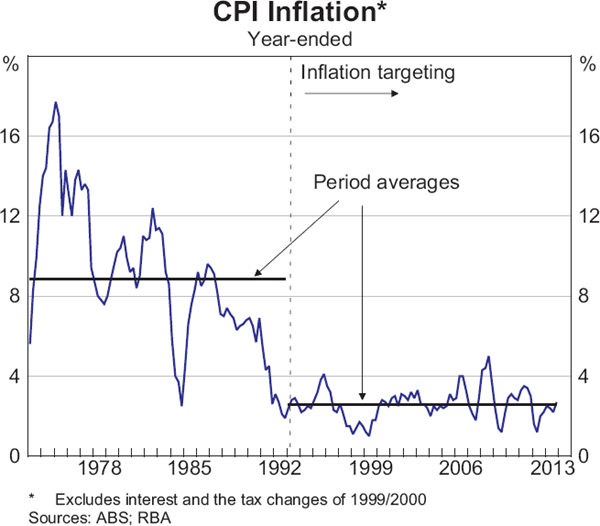
However, the CPI is not an ideal measure of changes in the cost of living. In very broad terms, cost-of-living inflation means the increase in household spending needed to maintain a constant standard of living.[1] The CPI is a measure of the price of a fixed basket of goods and services, with unchanged composition and quality over time. This approach is relatively practical and gives the CPI certain properties that make it attractive as a target for monetary policy.[2] However, there are several reasons why the CPI might not fully reflect household concerns about cost-of-living inflation. In particular, this article addresses three key questions about using the CPI as a measure of increases in households' cost of living:
- How closely does the CPI reflect cost-of-living inflation? While there is no perfect measure of cost-of-living inflation, a number of alternative measures are available.
- How different is inflation across households? The CPI, together with alternative indices, measures the average rate of inflation across households. But the rates of inflation for individual households are dispersed around the average, because consumption baskets differ and not all prices increase at the same rate.
- What factors might affect households' perceptions of inflation? While the CPI is calculated from a very large number of prices (around 100,000 each quarter), individuals have much less information with which to assess the general rate of inflation. Accordingly, measured inflation may not align with perceptions of inflation from the standpoint of households.[3]
The CPI and Cost-of-living Inflation
The CPI is designed to measure inflation in the prices of household goods and services. While the rate of inflation in prices is likely to be similar to that in the cost of living, there may also be some differences. In addition, there are some constraints to measuring CPIs in practice, both in Australia and internationally, that might affect the measured rate of inflation. Accordingly, CPI inflation may be expected to differ from cost-of-living inflation in a predictable way. These issues are relatively complex, so a full treatment is presented in Appendix A (also see ABS (2011)). However, three aspects are particularly important:
- Substitution bias. Consumers will try to lessen the impact of price increases on their cost of living by shifting their spending from higher inflation to lower inflation items. The CPI does not capture much of this behaviour because it is based on a fixed basket (at the ‘upper level’; see Appendix A) that is updated every six years or so. This results in an upward ‘substitution’ bias relative to cost-of-living inflation. The Australian Bureau of Statistics (ABS) estimates that this bias has been around ¼ percentage point per year since 2000 (ABS 2011). Similarly, consumers' efforts to shop around between outlets to obtain the best price are not fully captured in the CPI. This can result in a further upward bias, which may have become larger in recent years owing to the increased prevalence of online shopping (RBA 2011).
- Incomplete quality adjustment. The quality of goods and services tends to improve on average over time, helping to lift living standards. If prices increase in line with quality, then the cost of living is unchanged, while if prices are unchanged but quality improves, then the cost of living has declined.[4] Therefore, recorded prices need to be adjusted downward to account for the effect of quality improvements. The ABS performs explicit quality adjustments for items such as personal computers, which tend to have large quality improvements over time and have easily measureable characteristics. However, for certain items, it is particularly difficult to measure quality and therefore to adjust for improvements. This is true of services such as health and education, where the quality changes are less tangible than for many goods. Where quality is more difficult to assess, CPI inflation can potentially reflect an element of quality improvement, which is not a genuine rise in the cost of living. In other words, in this case CPI inflation can overstate cost-of-living inflation.
- Treatment of housing. One of the most challenging items to measure in the CPI is the price of living in a dwelling that is owned by the occupant (as opposed to rented). The CPI takes the approach of evaluating the price of buying a newly built, free-standing house (excluding the cost of the land). Changes in the price of established housing are not taken into account, as these largely reflect changes in the value of an asset (land) and, moreover, the purchase of existing housing represents a transfer within the household sector (which means that there is zero net expenditure by the household sector in these transactions).This approach is appropriate given that the CPI is used as a target for monetary policy (see ABS (2010)). However, two alternative approaches are possible. One is to measure the cost of servicing a mortgage on the property, which might align more closely with households' perceptions of their expenses. A more difficult alternative is to recognise that, by living in dwellings, owners are effectively renting properties from themselves; in this case, an ‘imputed’ rent must be estimated.[5]
A large body of academic research has estimated the effect of these factors on the rate of inflation as measured by the CPI, both in Australia and internationally (Table 1; Appendix A). Some of the factors are likely to push CPI inflation higher and others lower, and their relative importance is likely to change over time. However, the overall effect is likely to be positive, meaning that CPI inflation would generally be expected to overstate cost-of-living inflation.
| Source of bias | Estimated effect on CPI inflation relative to ‘true’ cost-of-living inflation(a) |
|---|---|
| Substitution bias | +¼ to +½ |
| Incomplete quality adjustment | +0 to +½ |
| Treatment of housing(b) | – (+) when mortgage interest rates rising (falling) |
|
(a) Positive figure indicates that factor pushes up CPI inflation; range of estimates
based on studies of both Australian and international CPI inflation Sources: see Appendix A |
|
Several other measures of inflation are available that provide an alternative means of assessing increases in the average cost of living. These measures are constructed differently from the CPI, and so are affected differently by the biases discussed above.
Generally speaking, they are also closer in concept to a measure of cost-of-living inflation as opposed to price inflation (see ABS (2011)). The national accounts use a measure called the household final consumption expenditure chain price index (HCPI). This measure should be less affected by substitution bias than the CPI (as it is reweighted each year) and it measures the price of owner-occupied housing as implied rent. The ABS also publishes analytical living cost indices (ALCIs); these measure the price of owner-occupied housing on the basis of mortgage interest payments. The ALCIs are only available for specific household types, and the ABS does not publish an aggregate measure. However, an aggregate measure over different household types is produced by the National Centre for Social and Economic Modelling (NATSEM).[6]
Despite their different approaches, and some temporary deviations, these measures have risen by similar amounts over the past decade or so. The three measures all indicate inflation in the range of 33–36 per cent over the period since 2003 (Graph 2). So, while the CPI is subject to certain biases when used to assess cost-of-living inflation, these have either tended to even out over a long period of time or have been present in other measures to a similar degree.
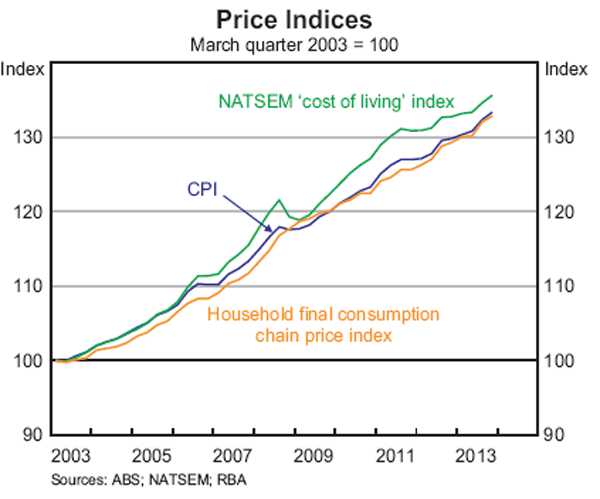
Inflation for Different Households
Inflation rates vary across households due to different spending patterns and because not all prices increase at the same rate. As a result, the official aggregate measures will only approximate cost-of-living inflation for many households. At any given time, roughly half of households will have experienced inflation somewhat above the average for all households, because they spent proportionately more on high-inflation items, while the other half will have experienced inflation below the average, because they spent proportionately more on low-inflation items.[7] In addition, a household's consumption basket is usually influenced by certain socio-economic characteristics, such as income, housing tenure or demographics, resulting in differences in cost-of-living inflation between certain socio-economic groups.
Two main data sources are available that permit an analysis of the distribution of inflation across households:
- The ALCIs published by the ABS measure cost-of-living inflation across households according to their main source of income, with inflation measured for employees, age pensioners, recipients of other government transfers and self-funded retirees. But to examine differences in inflation at the more granular level of individual households, or to look at differences on the basis of other household characteristics, a different data source is needed.
- To construct the data needed for this additional analysis, we make use of individual responses to the Household Expenditure Survey (HES). The HES collects information from a sample of around 10,000 households and is conducted every five or six years, with the results used by the ABS in calculating the ALCIs as well as the CPI. For each respondent household in the HES, we calculate an inflation rate by combining information from the HES on that household's reported consumption basket and state of residence, together with CPI inflation data disaggregated by expenditure class and capital city. In addition, we use demographic data available for each household in the HES to construct average cost-of-living inflation for different socio-economic groups. These groups are defined by several characteristics: housing tenure, level of income, family structure, age of reference person and location. For this exercise, inflation in owner-occupied housing costs is measured on the basis of mortgage interest payments (in line with the ALCIs) rather than the cost of new dwellings (as used in the CPI). For further details on the construction of these data, see Appendix B.
Short-term differences
Based on the data constructed using the HES, the distribution of inflation rates across households looks to have been fairly narrow over the past decade. In most years, less than 5 percentage points have separated the inflation rates of the middle 80 per cent of capital city households (Graph 3). At times, the distribution has widened and become ‘skewed’, because a group of households experienced well above-average or well below-average inflation. A major driver of these short-term differences in inflation across households has been interest rate movements, which tend to have a large influence on living costs for the roughly one-third of households with a mortgage. In contrast, for households that rent or own their home outright, mortgage rates do not directly affect their cost of living. As a result, when interest rates have risen, households with mortgages have tended to face higher cost-of-living inflation than other households (Graph 4). And when interest rates have fallen, such as over the past two years, mortgagor households have experienced lower inflation than other households, with the cost of living even falling for some.
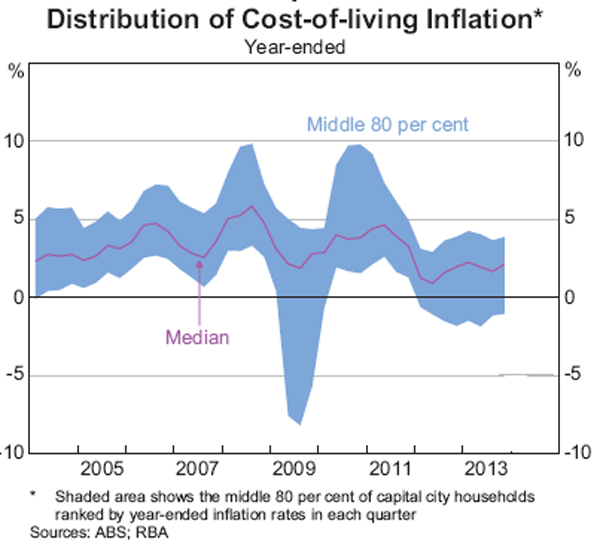
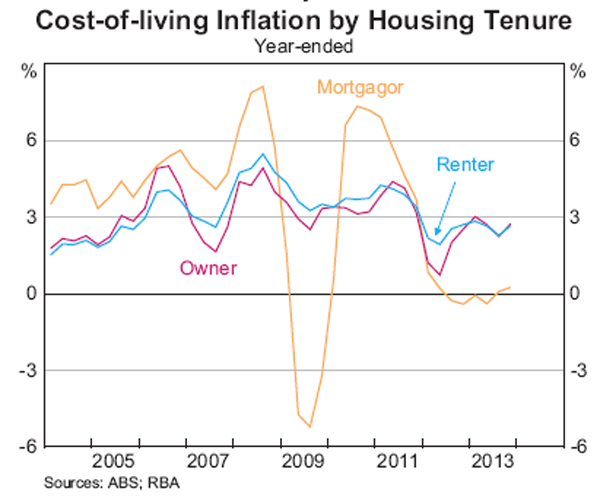
Differences in cost-of-living inflation across households that have different sources of primary income can also be largely explained by changes in mortgage rates, at least in the short-term. Households for which employment is the main source of income are more likely to have a mortgage. So, according to the ABS' ALCIs, changes in mortgage rates have had a relatively large effect on cost-of-living inflation for these employee households (Graph 5). In contrast, self-funded retirees, pensioners and other government transfer recipients are all less likely to have mortgages, so their cost of living is less affected by interest rates.

While cycles in interest rates have been the main source of differences in cost-of-living inflation between households over periods of a year or so, over a longer horizon these influences have largely evened out. Accordingly, differences in cost-of-living inflation across households over a longer period of time have reflected other aspects of their spending patterns, together with longer-term differences in the rates of inflation across the basket of consumption items.
Long-term differences
Looking over a longer horizon, there have been large differences in the rate of inflation for different goods and services in the CPI. Over the past decade or so, services such as education, health care and utilities have seen prices rise by more than the overall rate of CPI inflation (Graph 6). Other items have experienced inflation below overall CPI inflation and for some consumer durables, including clothing, footwear, and audio, visual & computing equipment, prices have even declined. These goods are manufactured and often imported, with declines in prices having reflected significant improvements in productivity, sourcing from low-cost economies (particularly in Asia), the appreciation of the exchange rate over the past decade and intense retail competition (both domestically and, for some items, from overseas online stores).
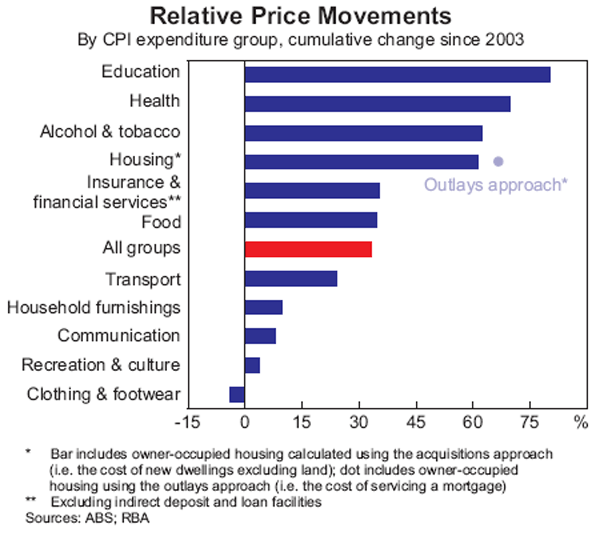
Despite these large differences in inflation across items, differences in cost-of-living inflation among different groups in society have been fairly small over the past decade. As explained above (and in Appendix B), we use HES data to construct average inflation rates over a range of household characteristics – level of income, source of income, housing tenure, family structure, age and location. The differences in inflation for different groups, as defined by these characteristics, have cumulated to no more than around 6 percentage points over the past decade (Table 2). That is, for all groups, cost-of-living inflation has not differed much from the average pace captured by the CPI or other measures of aggregate inflation because, while inflation has varied markedly among different items, the consumption bundles of different households are fairly similar.
| Share of households | Cumulative inflation since 2003 | |
|---|---|---|
| Disposable income | ||
| Lowest quintile | 20 | 39 |
| 2nd | 20 | 36 |
| 3rd | 20 | 35 |
| 4th | 20 | 36 |
| Highest quintile | 20 | 35 |
| Principal source of household income(b) | ||
| Wages and salaries (employees) | 65 | 33 |
| Age pension(c) | 10 | 36 |
| Other government transfers | 10 | 38 |
| Property income incl superannuation (self-funded retirees) | 5 | 32 |
| Housing tenure | ||
| Mortgagor | 38 | 36 |
| Owner | 31 | 36 |
| Renter | 29 | 38 |
| Family structure | ||
| Family with dependent children | 33 | 35 |
| Family without dependent children, head aged under 45 | 13 | 34 |
| Family without dependent children, head aged over 45 | 26 | 35 |
| Lone person or non-family group household | 28 | 39 |
| Age of household reference person | ||
| 15–24 | 4 | 35 |
| 25–34 | 19 | 36 |
| 35–44 | 21 | 36 |
| 45–54 | 21 | 36 |
| 55–64 | 17 | 36 |
| 65+ | 19 | 37 |
| Area of residence | ||
| Adelaide | 6 | 36 |
| Brisbane | 9 | 37 |
| Hobart | 1 | 33 |
| Melbourne | 18 | 37 |
| Perth | 8 | 37 |
| Sydney | 20 | 35 |
| ACT or NT | 2 | 37 |
| Outside state capital cities and territories | 36 | 36 |
|
(a) Period from December quarter 2003 to December quarter 2013; share of households
calculated across capital city households in 2009/10, except where otherwise
stated Sources: ABS; RBA |
||
There have been differences in inflation for households with different levels of income. Over the past decade, low-income households have experienced slightly higher rates of inflation than high-income households. Low-income households tend to spend proportionately more on items that are relatively ‘essential’ in their nature, particularly housing and food, which has resulted in them being more exposed to relatively large increases in utility prices over this period (Graph 7). In addition, high-income households spend proportionately more on items that are relatively ‘discretionary’, such as recreation and consumer durables. They have consequently benefited more from the relatively slow pace of inflation in items such as motor vehicles, overseas travel and clothing over this period.[8]
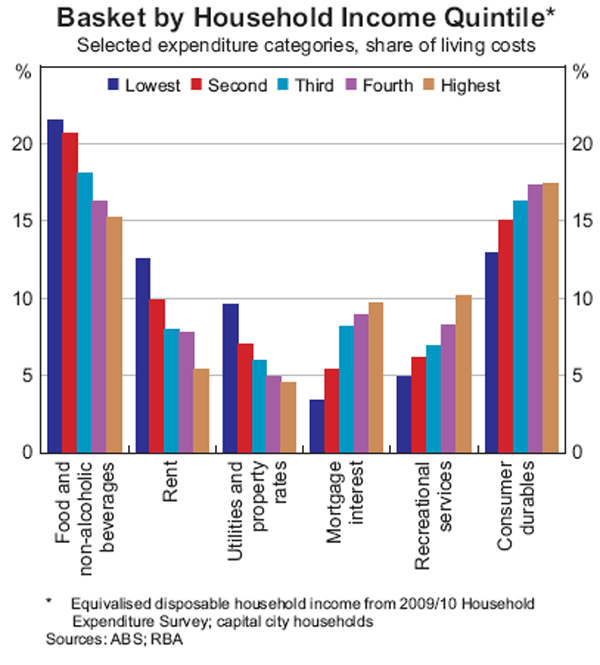
Inflation reduces the amount of goods and services that can be bought with a given level of household income – that is, by itself it reduces ‘real’ incomes. So the slightly higher rate of inflation for low-income households over the past decade has weighed more on the growth in their real incomes than has been the case for high-income households. However, this difference has not been large, with inflation for the lowest income quintile only around 4 percentage points more than the highest income quintile over the course of a decade. Accordingly, it has still been the case that nominal income growth has outstripped increases in the cost of living; that is, real incomes have increased for all income groups (Graph 8). Moreover, differences in real income growth between groups have primarily reflected differences in nominal income growth, rather than differences in inflation.
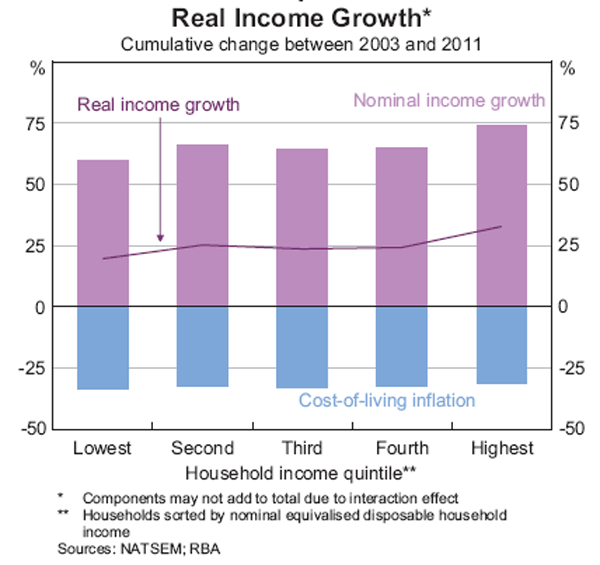
Perceptions of Inflation
According to a range of measures, cost-of-living inflation has been moderate and consistent with the RBA's target for CPI inflation over the past decade. In addition, differences in inflation across different household types have not been large. Nonetheless, the cost of living is a source of significant concern for households (Graph 9). This is likely to reflect concerns about both the level of prices and the rate of inflation. One factor that may contribute to these concerns is perceptions of inflation. Households may perceive inflation to be higher than measured inflation, either due to biases in their perceptions or because they interpret the cost of living differently from the standard statistical measures.
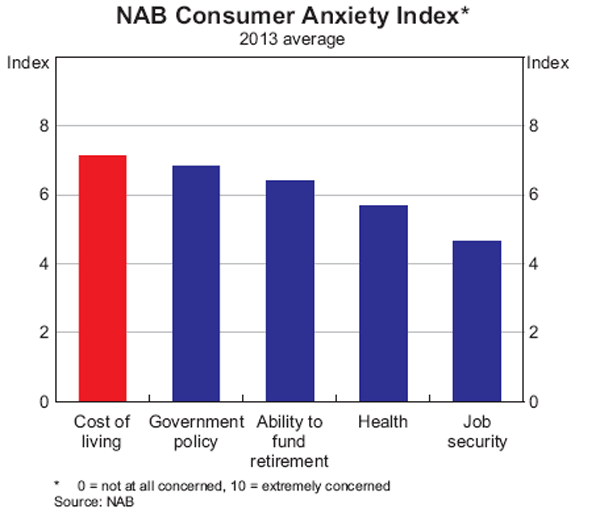
Psychological biases
The CPI uses extensive survey data on price movements and the weights of different items in consumers' baskets. By comparison, individuals have substantially less information on economy-wide prices and their relative importance. Research in Australia and internationally has found that individuals tend to place a greater weight on:[9]
- prices that have risen, rather than fallen. This is in line with the finding that people are ‘loss averse’, and so would prefer no change in prices to two offsetting price changes – either in the same item over time or in different items in the basket at the same point in time.
- larger price changes, particularly those that change periodically rather than smoothly. Consumers tend to take more note of prices that increase only once or twice each year (such as many administered prices like utilities, education and pharmaceuticals), rather than smoothly throughout the year (Graph 10). In the quarter that these periodic changes occur, their magnitude is typically much larger than price changes that are spread more evenly throughout the year. In recent years many of these administered items have also experienced higher rates of inflation than the overall CPI.
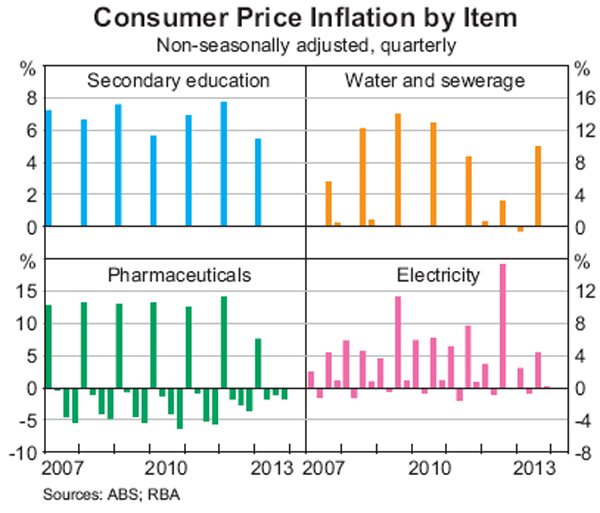
- prices for items that are purchased frequently. These include food and fuel, which have volatile prices, with periods of large price increases as well as decreases. In contrast, consumer durables such as computers and motor vehicles are purchased less frequently, and have declined in price (partly through improved quality) over the past decade.
Quality adjustment
While statistical measures of inflation are adjusted for changes in quality (where possible), it is difficult for individuals to adjust for quality changes when observing inflation. Recent advances in smartphone technology provide a case in point. Progressive releases of new iPhone models in recent years have been priced similarly; an individual could easily conclude that prices have been little changed, as it is difficult to determine what value to place on the improved features of newer models. However, a rough estimate of the improvement in value from improvements along dimensions such as processing speed, screen quality, etc, can be found by comparing the price of an iPhone 4 a few years after its release with that of the newer model, and adjusting for differences in storage capacity. This comparison suggests an effective price decline of around 35 per cent between 2010 and 2012 (Graph 11).[10]
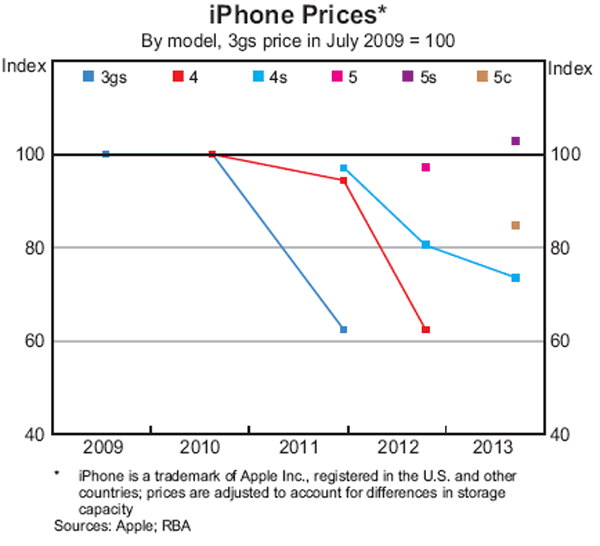
More generally, items with large improvements in quality (and therefore value for money) have subtracted substantially from the pace of CPI inflation. An upper estimate of the size of this effect can be seen from excluding several items that have seen particularly large quality improvements – audio, visual & computing equipment, household appliances and motor vehicles. While other factors have also contributed to measured price falls for these items, together they have subtracted around ½ percentage point each year from the rate of aggregate inflation since 2003.
Changes in ‘reasonable’ living standards
Over time, individuals may not compare the cost of achieving the same standard of living, but rather that of a ‘reasonable’ standard of living. Real consumption per person has risen substantially over time, indicating that living standards have increased (Graph 12). Thereby, it is likely that the notion of what is a reasonable standard of living has also increased, as households have become accustomed to consuming more goods and services and those of a higher quality. As a result, perceived increases in the cost of living may partly reflect the cost of attaining a higher standard of living for many households. There is also evidence that individuals' perceptions about their wellbeing are formed not purely in absolute terms, but partly by comparing themselves with those around them – colloquially termed ‘keeping up with the Joneses’ (Guven and Sørensen 2011).

International comparisons
Perceptions of the increase in the cost of living in Australia can also be affected by changes in the price of items in Australia relative to overseas. Over the past decade, prices in Australia have risen relative to those in many other developed economies when converted to a common currency, owing mainly to the appreciation of the Australian dollar over this period (Graph 13).[11] The increasing use of online shopping has also made overseas prices more visible than previously.
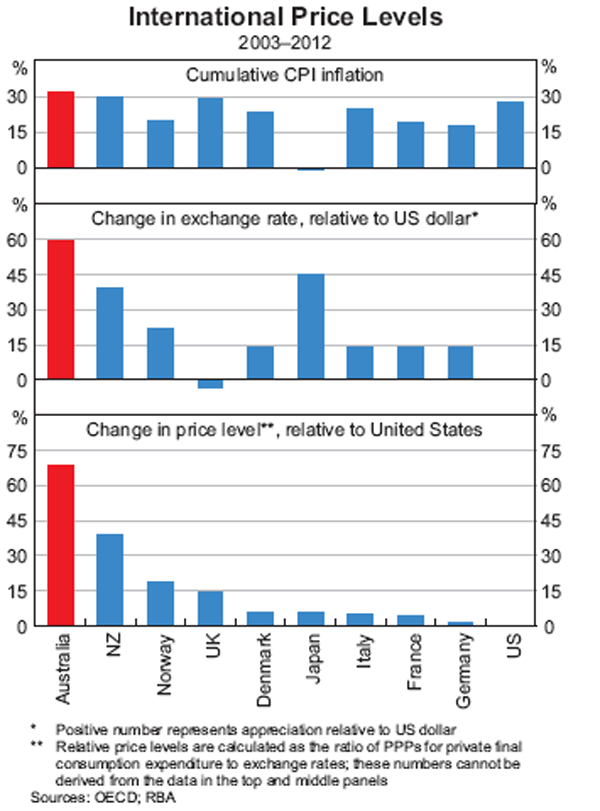
This rise in relative prices in Australia does not represent an increase in the cost of living for Australians. In fact, the appreciation of the exchange rate has also seen Australian incomes, paid in Australian dollars, rise relative to those of many other developed economies.
Conclusion
On balance, the CPI has provided most households with a good gauge of the extent to which living costs have increased over time. According to the CPI and other measures, inflation has been moderate and consistent with the Reserve Bank's target for CPI inflation over the past decade. As would be expected, some households have experienced a rate of inflation above or below these aggregate measures. But such differences have not been particularly large and have mainly reflected changes in interest rates in the short term, as these have a greater effect on living costs for mortgagor households. However, over longer horizons, the effects of interest rate movements have tended to wash out and inflation rates across different groups in society have been similar. To the extent that differences have occurred, these may have been specific to the time period considered and do not suggest that groups that experienced higher-than-average (or lower-than-average) inflation will continue to do so in the future.
Even though the CPI has been found to be a good proxy for increases in living costs for the bulk of households, the cost of living remains a concern for many in the community. This is despite nominal incomes generally having risen by more than the cost of living for all income groups, which suggests that spending should be less constrained by incomes than was the case a decade ago. The continued concern about living cost pressures might arise because the standard of living that can be sustainably afforded by households' incomes remains lower than many would like. Alternatively, it may be that many households perceive that their inflation has been higher than the measured rate over time, reflecting the inherent difficulty of assessing the rate at which the general price level has increased.
Appendix A: Biases in CPI Inflation as a Proxy for Cost-of-Living Inflation
This appendix expands on the discussion of potential biases in CPI inflation when used as a proxy for cost-of-living inflation. These biases reflect the conceptual basis of the CPI as a measure of inflation in the prices of goods and services, rather than of inflation in the cost of living, as well as practical issues of measurement. They are well known and are similar both in Australia and internationally. For further details, see ABS (2011). The following papers provide estimates of the potential magnitude of these biases: Boskin et al (1996); Cunningham (1996); Gordon (2006); Hoffman (1998); and Sabourin (2012).
Substitution bias
Because the CPI is based on a fixed basket, which is revised only every six or so years, it does not fully capture the moderating influence of substitution on the cost of living, biasing CPI inflation upwards. For example, if the price of beef increases by more than the price of fish, then consumers are likely to consume more fish and less beef. This bias is referred to as upper-level substitution bias, so-called because the CPI basket is fixed with respect to broad, upper-level groupings of goods and services (called expenditure classes).[12] One way in which this bias can be reduced is to update the basket more frequently, such as by using electronic transaction data from retail outlets. Such an approach has been implemented by some overseas statistical agencies (Ivancic 2010). The ABS is planning to introduce transaction data in the construction of the CPI (ABS 2013). In the first instance this will involve replacing prices collected ‘in the field’ with prices derived from transaction data, although in the future these data may be used for more frequent updating of the weights (below the expenditure class level) used in the index calculation.
A related bias arises from consumers' ability to shop around between outlets. If consumers buy an item from an outlet with a lower price, the CPI is unaffected; the price difference is assumed to reflect service or convenience. However, over time some outlets may offer a genuine saving to consumers. The result is an outlet substitution bias whereby CPI inflation overstates true inflation in the cost of living. Overseas evidence suggests that outlet substitution bias tends to be small, amounting to around 0.1 percentage point each year. However, this bias may have risen in recent years with the increase in online shopping. The significant growth in the share of purchases made online suggests that consumers view the lower prices that are often available online as outweighing any loss in service or convenience, providing a genuine reduction in the cost of living (Graph A1).[13]
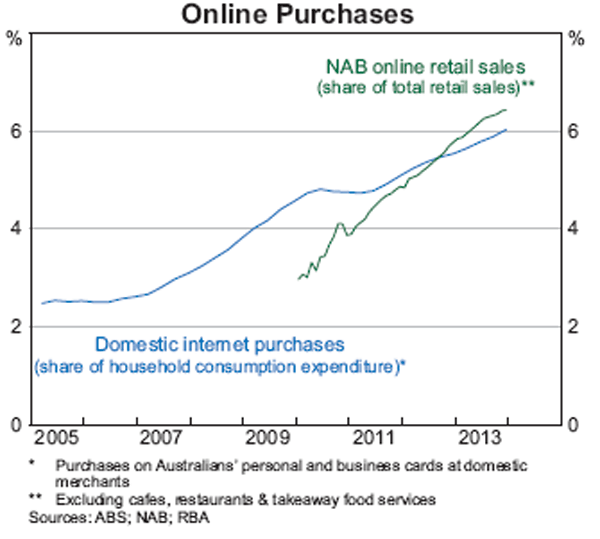
Altogether, upper-level and outlet substitution bias mean that CPI inflation is biased higher relative to cost-of-living inflation. Across a range of countries, this is estimated to overstate inflation by around ¼ to ½ percentage point per year.[14]
Quality adjustment
Improvements in quality are a key driver of rising living standards over time. The CPI is adjusted for certain quality changes, using a variety of methods based on product size, production costs, expert judgement and more advanced statistical techniques (‘hedonics’). However, adjusting for quality change is difficult in practice, and it can give cause to a number of biases of CPI inflation relative to cost-of-living inflation:
- Incomplete quality adjustment: It is difficult (if not impossible) to measure changes in the quality of many items, particularly services. Where this is the case, the ABS generally does not make explicit quality adjustments, potentially leading to an upward bias in CPI inflation relative to cost-of-living inflation. In particular, there is generally no explicit adjustment for changes in the quality of health, education, personal services, recreation and child care (although there are some implicit adjustments). This may explain some of the relatively high rates of measured inflation in these services over the past decade. As services have become a larger share of household spending over time, the overall importance of this bias may have increased.
- Quality versus utility: Explicit quality adjustments are made on the basis of measureable characteristics. However, these may not align precisely with the benefit that consumers receive from a product. For example, it is not clear how much a doubling in computer processing speed will add to consumer utility. This problem can cause statistical agencies to over- or underestimate the effect of quality change on consumer utility.
- Forced upgrades: When an improved model of a good is introduced, the older model often disappears from the market. This ‘forced’ upgrade may not result in an increase in utility and could cause quality adjustment to bias CPI inflation downwards.
Studies overseas have generally found incomplete quality adjustment to be the most important of these biases, resulting in an overall positive bias in the CPI relative to cost-of-living inflation. Estimates of the bias range from zero to around half a percentage point per year.[15]
New goods
As new types of products become available, the ABS must decide when to begin including them in the CPI. The ABS generally takes a conservative approach and only includes items that have clearly gained widespread acceptance (ABS 2011). New products that fall into a completely new expenditure class, such as DVD players when they were first introduced, are only included when the index is reviewed and reweighted every five or six years. Accordingly, the price declines that occur early in a new product's life – as production processes improve and economies of scale are achieved – are generally missed in the calculation of the CPI, which imparts an upward bias on the index. The effect of new products is generally thought to be small relative to the other sources of bias at around 0.1–0.2 percentage points annually.
Measurement approach
In Australia, the CPI measures prices at the point that items are acquired (the acquisitions approach). This suits the use of the CPI as a policy target, as it provides the best indication of current inflation pressures. However, the use of a good or service is more closely related to the cost of living, as it is the use of an item that provides utility (the cost of use approach). An alternative approach is to measure prices at the point of payment (the outlays approach), which is most consistent with calculating real incomes.
In many cases, the difference in approach is of little or only temporary consequence. However, the difference is significant for durable goods, which are used over an extended period of time after they are acquired, and which are often paid for only gradually with the use of credit. The most obvious example of this is owner-occupied housing (see ABS (2010)). Under the acquisitions approach, the price of owner-occupied housing is the price paid to acquire a new dwelling (excluding land), which is unaffected by whether borrowed funds are used. In contrast, the outlays approach measures the amount of interest paid on mortgages, as this is a necessary out-of-pocket expense to ensure continued use of the dwelling. The inclusion of mortgage interest is not appropriate for a measure of inflation used as a target for monetary policy, as changes in the cash rate directly affect the measure of inflation. This was a key reason for changing the conceptual basis of the CPI from the outlays to acquisitions approach in 1998. Finally, the cost of use approach is concerned with the economic cost of using the dwelling in the relevant period. This is measured by the implicit rental value, which is generally not observable and for owner-occupied housing must be imputed by using estimates from observed rents paid in the rental market.
Appendix B: Distribution of Inflation – Data and Method
This appendix provides further details regarding the use of HES data to estimate cost-of-living inflation rates at the household level and for different groups of households. The method applied is as follows:
- Data on consumption baskets are sourced from the 2003/04 HES and the 2009/10 HES. The HES is the main source of expenditure weights in the CPI. Changes in consumption baskets over this period are captured only once, and were introduced into the estimates of cost-of-living inflation from the June quarter 2011, in line with the construction of the CPI.[16]
- Data for inflation by disaggregated expenditure class and by capital city are sourced from the CPI. The rate of inflation of a particular item is assumed to be the same for all households within a state (although price levels may vary). The outlays approach is used, rather than the acquisitions approach used in the CPI. For measuring inflation of owner-occupied housing, mortgage interest indices are sourced from ABS Selected Living Cost Indexes. Inflation in these indices partly reflects house price inflation, as the interest payments on a loan with a given loan-to-value ratio would change with the size of the loan, which in turn would vary with the price of housing.[17] Repayments on higher education loans are also included rather than the total cost of the education. Gross insurance premiums are used rather than the value of premiums net of the expected value of claims, and the cost of financial services is excluded.
- The analysis of geographical differences in cost-of-living inflation is limited by the availability of data. The scope of the CPI is households living in capital cities, while the HES dataset also includes households located outside capital cities. In addition, mortgage indices are only available at the national level.
There are reasons to be cautious when using these estimates. Substitution might act to reduce the width of the distribution of household-level inflation rates relative to our estimates. In addition, part of the estimated variation between household inflation rates reflects differences in whether households recorded expenditure on infrequently purchased items within the HES recall period. Working in the other direction, different households might experience different rates of inflation for the same item within the same state, which would lead to the width of the distribution being underestimated in the absence of this information.
Footnotes
The authors are from Economic Analysis Department. [*]
The ‘standard of living’ can be thought of as the utility that a household derives from consuming goods and services. [1]
Because the CPI is based on a fixed basket, it provides a measure of ‘pure’ price changes, unaffected by compositional change, and it is a good gauge of the extent to which spending is running above or below the economy's production capacity. [2]
For previous analysis of these issues, see Phillips, Li and Taylor (2012). [3]
More precisely, price increases will be offset by increases in consumer utility resulting from improvements in quality (see Appendix A). [4]
None of these measures perfectly captures the issue of housing affordability, which is indicative of the complexity of this issue. For example, increases in new or established dwelling prices affect housing affordability for prospective first home buyers, but have little impact on affordability for those who have a mortgage. On the other hand, changes in interest rates can influence affordability for both aspiring home buyers and those with a mortgage. [5]
For details of this measure, see Phillips, Li and Taylor (2012). [6]
The share of households with inflation above and below official aggregate measures will not be exactly half, because households are weighted according to spending in the construction of these measures and because the distribution of inflation among households can be skewed. Also, a household experiencing above-average inflation one period may experience below-average inflation the next. [7]
Working in the other direction, high-income households are more likely to have a mortgage, which has added to their inflation, as average interest repayments on houses have risen faster than rents, in line with rising house prices over this period. [8]
This is referred to as ‘availability bias’. For further discussion, see Tversky and Kahneman (1974), Bates and Gabor (1986), Fluch and Stix (2005), Jungermann et al (2007), Brachinger (2008), Ranyard et al (2008) and Bruine de Bruin, van der Klaauw and Topa (2011). [9]
This figure of 35 per cent is calculated as the difference between the iPhone 4 price in 2012 and the price of the newly released iPhone 5 at the same point in time. All prices are adjusted for differences in storage capacity, as Apple generally only offers the older models in smaller storage capacities than the latest model. iPhone is a trademark of Apple Inc., registered in the United States and other countries. [10]
Australia has also had higher average inflation than most of these countries in recent years, owing to a slightly higher inflation target and generally better economic outcomes, which has meant that Australia has not undershot its inflation target like many other countries have since the global financial crisis. [11]
Another potential bias is ‘lower-level’ substitution bias, which refers to substitution within an expenditure class. Lower-level substitution bias is thought to be negligible as the construction of the Australian CPI allows for substitution between different types of the same item. [12]
The ABS undertakes sample maintenance to ensure that collection is focused on representative outlets. [13]
Results vary across time and country. An alternative approach using Engel curves suggests a bias estimate closer to 1 percentage point annually (e.g. Barrett and Brzozowski (2010) for Australia). However, this approach may itself be biased (Beatty and Crossley 2012). [14]
The wide dispersion of estimates reflects the differing impact of quality bias across countries and over time, while studies of these biases are also exposed to many of the same difficulties as statistical agencies in attempting to quantify quality change. [15]
Sampling weights were used when aggregating the HES households into population groups in order to ensure that the results obtained from the survey were representative of the population. [16]
The drawback to this approach is that housing price inflation is unlikely to affect the cost of living of any specific household with a mortgage. Rather, its influence reflects the change in the cost of servicing a mortgage with fixed characteristics (with regards to its maturity and loan-to-value ratio), for a fixed quality of housing, over time. [17]
References
ABS (Australian Bureau of Statistics) (2010), ‘Information Paper: Outcome of the 16th Series Australian Consumer Price Index Review’, ABS Cat No 6469.0.
ABS (2011), ‘Consumer Price Index: Concepts, Sources and Methods’, ABS Cat No 6461.0.
ABS (2013), ‘The Use of Transactions Data to Compile the Australian Consumer Price Index’, in ‘Consumer Price Index, Australia’, ABS Cat No 6401.0, September, pp 3–7.
Barrett GF and M Brzozowski (2010), ‘Using Engel Curves to Estimate the Bias in the Australian CPI’, The Economic Record, 86(272), pp 1–14.
Bates JM and A Gabor (1986), ‘Price Perception in Creeping Inflation: Report of an Inquiry’, Journal of Economic Psychology, 7(3), pp 291–314.
Beatty TKM and TF Crossley (2012), ‘Lost in Translation: What Do Engel Curves Tell Us about the Cost of Living?’, Working Paper, University of Minnesota.
Boskin MJ, ER Dulberger, RJ Gordon, Z Griliches and D Jorgenson (1996), ‘Toward a More Accurate Measure of the Cost of Living: Final Report to the US Senate Finance Committee’, in US Senate Finance Committee. Senate Print 104-72, December, 104th Congress, 2nd Session, Government Printing Office, Washington DC.
Brachinger HW (2008), ‘A New Index of Perceived Inflation: Assumptions, Method, and Application to Germany’, Journal of Economic Psychology, 29(4), pp 433–457.
Bruine de Bruin W, W van der Klaauw and G Topa (2011), ‘Expectations of Inflation: The Biasing Effect of Thoughts about Specific Prices’, Federal Reserve Bank of New York Staff Report No 489.
Cunningham A (1996), ‘Measurement Biases in Price Indices: An Application to the UK's RPI’, Bank of England Working Paper No 47.
Fluch M and Stix H (2005), ‘Perceived Inflation in Austria – Extent, Explanations, Effects’, Monetary Policy & the Economy, Q3/05, pp 22–47.
Gordon RJ (2006), ‘The Boskin Commission Report: A Retrospective One Decade Later’, NBER Working Paper No 12311.
Guven C and BE Sørensen (2011), ‘Subjective Well-Being: Keeping Up with the Perception of the Joneses’, Social Indicators Research, 109(3), pp 439–469.
Hoffman J (1998), ‘Problems of Inflation Measurement in Germany’, Economic Research Group of the Deutsche Bundesbank, Discussion Paper 1/98.
Ivancic L (2010), ‘Using Scanner Data in the Consumer Price Index’, Submission to the 16th Series Review of the Consumer Price Index, Centre for Applied Economic Research, University of New South Wales. Available at <http://www.abs.gov.au/websitedbs/d3310114.nsf/4a256353001af3ed4b2562bb00121564/ 915e99efbdbbe251ca2576e800280b1d/$FILE/Ivancic.pdf>.
Jungermann H, HW Brachinger, J Belting, K Grinberg and E Zacharias (2007), ‘The Euro Changeover and the Factors Influencing Perceived Inflation’, Journal of Consumer Policy, 30(4), pp 405–419.
Phillips B, J Li and M Taylor (2012), ‘Prices These Days! The Cost of Living in Australia’, AMPNATSEM Income and Wealth Report, Issue 31, May, Sydney, AMP.
Ranyard R, F Del Missier, N Bonini, D Duxbury and B Summers (2008), ‘Perceptions and Expectations of Price Changes and Inflation: A Review and Conceptual Framework’, Journal of Economic Psychology, 29(4), pp 378–400.
RBA (Reserve Bank of Australia) (2011), ‘Box B: Online Spending by Households’, Statement on Monetary Policy, February, pp 40–41.
Sabourin P (2012), ‘Measurement Bias in the Canadian Consumer Price Index: An Update’, Bank of Canada Review, Summer, pp 1–11.
Tversky A and D Kahneman (1974), ‘Judgment under Uncertainty: Heuristics and Biases’, Science, 185(4157), pp 1124–1131.